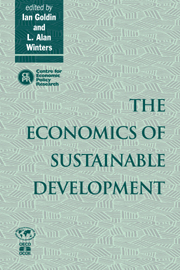Book contents
- Frontmatter
- Contents
- List of figures
- List of tables
- Preface
- Acknowledgements
- List of conference participants
- 1 Economic policies for sustainable development
- PART ONE GROWTH AND THE ENVIRONMENT
- PART TWO SUSTAINABILITY
- PART THREE DOMESTIC POLICY
- PART FOUR INTERNATIONAL POLICY COORDINATION
- 9 Carbon abatement, transfers and energy efficiency
- 10 Policy coordination for sustainability: commitments, transfers, and linked negotiations
- Discussion
- 11 Industrial competitiveness, environmental regulation and direct foreign investment
- Discussion
- Index
11 - Industrial competitiveness, environmental regulation and direct foreign investment
Published online by Cambridge University Press: 04 August 2010
- Frontmatter
- Contents
- List of figures
- List of tables
- Preface
- Acknowledgements
- List of conference participants
- 1 Economic policies for sustainable development
- PART ONE GROWTH AND THE ENVIRONMENT
- PART TWO SUSTAINABILITY
- PART THREE DOMESTIC POLICY
- PART FOUR INTERNATIONAL POLICY COORDINATION
- 9 Carbon abatement, transfers and energy efficiency
- 10 Policy coordination for sustainability: commitments, transfers, and linked negotiations
- Discussion
- 11 Industrial competitiveness, environmental regulation and direct foreign investment
- Discussion
- Index
Summary
Introduction
Environmental sustainability of economic growth hinges on the pollution intensity of output. If that intensity declines as growth progresses, through active policy or otherwise, economic growth within the confines of a limited resource base becomes at least possible. Recent econometric analysis has come up with intriguing results on this issue. For pollutants where most of the damage is done in the country where the pollution originates, intensities decline starkly after a particular level of per capita income is reached. However, for those pollutants where the costs fall on people living far away from the place where the pollution is caused, no such turning point can be observed (Grossman, 1994). When a significant part of the benefits of regulation accrues to people not contributing to the cost of the regulation, rules are difficult to put in place. Thus resolving the difficulties of bringing about international agreements on environmental standards, the topic of this chapter, may well be the key to resolving any conflict between economic growth and environment quality that may exist.
Such difficulties have been on prominent display recently. The typical pattern is for rich countries to insist on global harmonisation on tough western standards, with poorer countries baulking at the costs or likely impact on economic growth. Side payments, a possible solution to this conflict, create obvious budgetary and monitoring problems and are thus not on offer on a significant scale. As a consequence, little progress has been made in, for example, resolving the environmental problems of Eastern Europe's nuclear reactors, or the wide range of environmental issues that were on the table during the UN's environment conference in Rio de Janeiro in 1992.
- Type
- Chapter
- Information
- The Economics of Sustainable Development , pp. 289 - 302Publisher: Cambridge University PressPrint publication year: 1995
- 11
- Cited by

